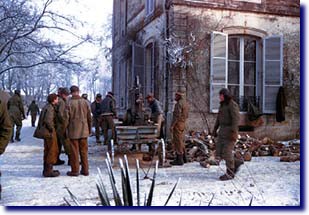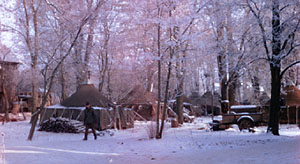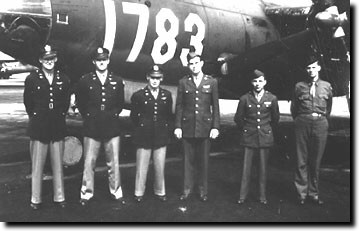![]()
Miracle
at Beauvais
Surviving a Midair Collision
by
Charles O'Mahony, 441st Bomb Squadron
|
||||||
|
In September 1944, the 322nd Bomb Group’s Martin B-26 base was moved from southern England to just outside the village of Beauvais, about 40 miles north of Paris, France. They arrived in time for what turned out to be the worst winter the last century had seen up to that time.
One of the four squadrons of the 322nd, the 451st, was bivouacked at the airfield in leaky tents staked down in an apple orchard. After a snowstorm, the crews frequently found a layer of ice on their GI blankets. The battle against the elements was almost as challenging as the conflict with the Germans. But on the night of Saturday, March 17 1945, the combat crew of the 451st had reason for celebration. It was, for openers, St. Patrick’s Day, and it was almost spring, so the bitter winter was loosening its grip. The ground and the group’s spirits were at last beginning to thaw. The War that had been raging in Europe for five and a half years was coming to an end; the weather looked good for the next day’s mission, and the scuttlebutt was that it would be “milk run.” Drinks were flowing, and off-key renditions of “Danny Boy” and “Toora-Loora-Looral” wafted from the tents and into the cold night air. But for Capt. Albert Pfleger and Staff Sgt. Marvin Shane, it was business as usual. Pfleger was the 451st’s Operations Officer; Shane was his clerk. In the operations office at the edge of the airfield, they were setting up Sunday morning’s mission. Any structure fancier than a tent was hard to come by on Beauvais airfield, and the ops office was a small, cement-block room with boarded windows. Ironically, while they were flying out of Great Saling, Essex, the 451st had bombed this field several times while it was occupied by the Luftwaffe, and they had done their usual first-rate job of it. The few buildings left standing had been badly damaged and the runway was pockmarked.
Several of the squadron’s crew were on rest leave - most of them in Paris - and Pfleger and Shane were patchworking crews together to man the 12 aircraft Group Headquarters wanted from the 451st the next day. Pfleger penciled in Lt. Alex Olaf Cordes' name as pilot of the lead Marauder and assigned Capt. George Snokelburg to be his navigator. Snokelburg saw action in B-24s in the Pacific and then volunteered for this second tour of duty. Cordes' plane would carry a Norden bombsight, and Lt. Wesley Myers would be lead bombardier. All three of Cordes’ enlisted men were on leave, so Pfleger assigned Tech. Sgt. Tom Colley as his radio operator, Staff Sgt. Jack Callaway as engineer, and Staff Sgt. Jack Fox as gunner on the twin .50-caliber tail guns. These three usually flew with Pfleger and his regular copilot, Lt. James Crumbliss, but this mission was anticipated to be a piece of cake, and they would be one closer to going back to the States.
Because they needed a navigator, Cordes’ B-26 would carry a seven-man crew, but the flight’s five other planes had crews of six. Pfleger soon assigned crews to the five other planes in Cordes’ flight - the first half of the next day’s quota - and he handed Shane the penciled pages to type up and post. Neither could have any intimation of the impending tragedy: that 18 of the revelers in the tents in the apple orchard were enjoying what would be their last evening on earth. Sunday started clear and sunny. At 0800 hours, Lt. Cordes taxied his Martin B-26 into position at the end of the runway and looked toward the tower. Born in Oslo, Norway, and raised in California, Cordes had completed a year and a half of college before enlisting in the Air Corps. This was his 58th combat mission, and he was about to lead a flight of 12, sleek, battle-ready Marauders, each carrying 4,000 pounds of bombs, and ammunition for the 11, .50-caliber machine guns, and 962 gallons of 100-octane gas. A green flare arched from the tower, and Cordes smoothed the throttles forward until the manifold pressure reached 52 inches and rpm steadied at 2,700. He let off the brakes, and the Marauder lunged for-ward on the rough runway. The bomb craters were filled with coarse rocks, and having a tire blow on takeoff was not uncommon. Cordes lifted the nosewheel off at 85mph and then sighed with relief as the airspeed hit 115mph and he was able to ease the big ship into the air. Flipping up his right thumb, he called, "Wheels up" to his copilot, Lt. Roy Rice. Moments later, he pulled the throttles back to climb power and signaled Rice with four fingers, “Give me 2,4OOrpm.” Stopwatch in hand, Snokelburg came forward from the navigator’s compartment and knelt behind the pedestal between the pilot and copilot. When Cordes released the brakes, the navigator clicked his stopwatch to begin clocking exactly five minutes. After that, their lead plane would begin a standard-rate turn to the left, 180 degrees in one minute, and would then continue on the reciprocal heading. The other five planes followed at 30-second intervals and, one by one, they would execute timed turns. Having done this precisely, they would a join up at an altitude of 1,000 feet just as they rolled out c their turns.(Continued) |

Copyright(c) 2003 320th History Preservation. All rights reserved.





















